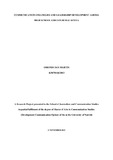| dc.description.abstract | Despite numerous deliberate efforts to nurture leadership competencies among girls, statistics
show that gender imbalance is still experienced both in appointment and election to public
and private sector. A number of organizations have made deliberate efforts to correct this
trend with little success. This research holds the view that the problem is not with the
initiatives but the communication strategies used to package this kind of information. The
study set out to investigate communication strategies and development of leadership
competencies among high school girls in rural Kenya. It adopted a descriptive study design
which used both quantitative and qualitative approach to data gathering. Qualitative data was
gathered through interviews with positive change agents, key informants‟ interviews with
leadership development experts and other strategic stakeholders. Additionally, the researcher
conducted structured participant observation of a model leadership development workshop.
The researcher purposively sampled one schools from Migori County and the other from
Homa Bay County. The study focused more on the perspective of the students being the
beneficiaries of these communication strategies as they boost their self-confidence and
leadership competencies. A descriptive survey was conducted with 130 students. In total 132
people participated in the research including 121 students and prefects. The researcher also
interviewed program implementers/positive change agents and experts in gender issues and
leadership development. The study sought to understand which specific competencies are
necessary for leadership that need to be nurtured; which methods are used to identify these
competencies; and to understand what challenges the implementers face in such leadership
development initiatives with a view to proposing ways of addressing them. Since this study
was generally based on girls learning leadership skills by observation and to some extent
imitation through personal contacts and interaction, the study adopted Albert Bandura‟s
social learning theory. Existing programs of leadership development amongst girls run by the
Women‟s Initiative in Education- NEWI and other organizations served as model
interventions and were used to draw lessons in the study. The researcher participated in girls‟
mentorship program sessions and interacted with the girls while recording his observations.
The sessions were held outside the conventional classroom settings to allow the girls a free
discussion atmosphere in a natural environment. Gathered quantitative data were processed
and analysed using descriptive analysis. The findings were presented in tables, graphs and pie
charts, and through narratives. Qualitative data were processed and analysed using thematic
analysis. Findings emanating from different sources and obtained through different tools were
triangulated to draw an all-encompassing conclusion. The study found that intelligence is the
most critical competency in leadership followed by assertiveness and boldness. However
physical appearance as a quality ranked low. All the four communication strategies were
useful, with most respondents preferring mentorship and role modelling as key methods of
developing leaders. The study concluded that communication strategies play a key role in
developing leadership both among girls and the society at large and more thought should be
put while planning one in an intervention. | en_US |

